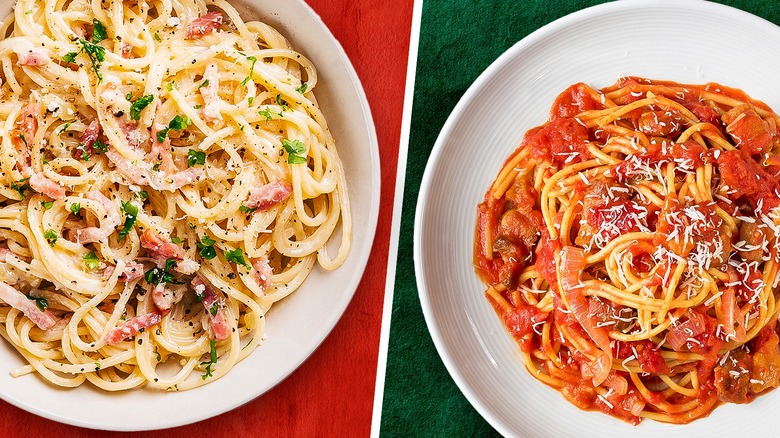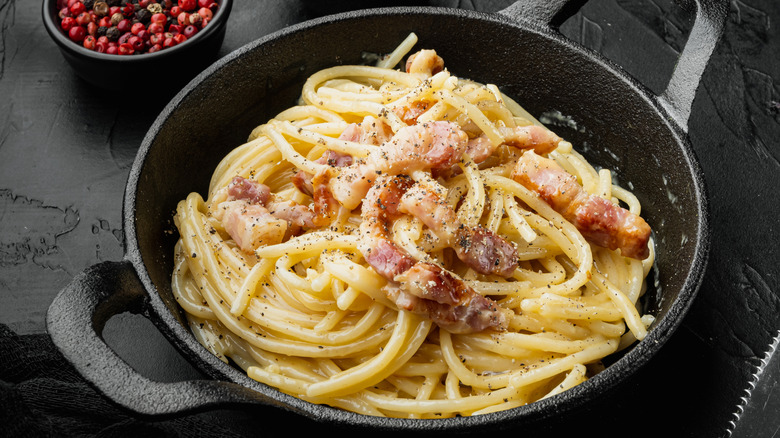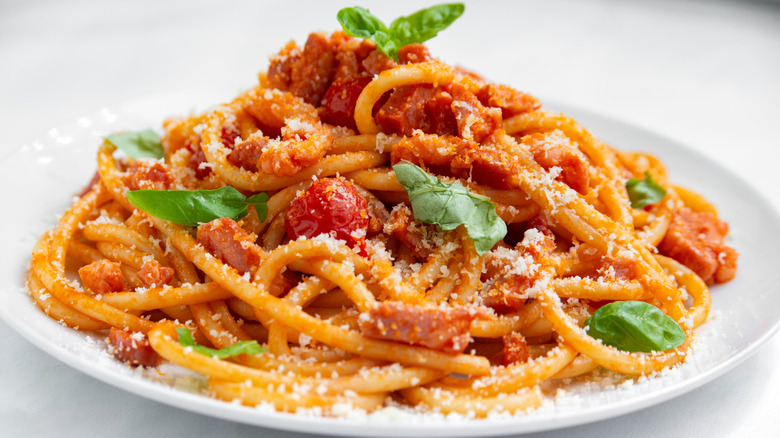Carbonara Vs Amatriciana: What's The Difference Between The Pastas?
When it comes to Italian cooking, the divinity lies in the details. Because Italian food culture is so centered around eating what's fresh and in season, dishes often contain many of the same ingredients. And yet — through magic or skill or the perfect amount of both — each dish is very much its own thing. Take carbonara and Amatriciana, for example.
Both are pasta dishes with sauces that contain Pecorino cheese and guanciale, generally served over long noodles. If you haven't heard of guanciale it's a cured cut of meat — sort of like pancetta — except it comes from the pig's fatty jowl. Pecorino, meanwhile, is a sharp, earthy cheese made from sheep's milk.
Pasta carbonara and Amatriciana are in a class of dishes that many Italians find to be "perfetto" — so traditional, they're beyond reproach. However, after tasting both dishes, you will never confuse one dish for the other. That's because carbonara — made with egg, cheese, and a light coating of salty pancetta grease — feels almost airy in comparison to the rich flavors of Amatriciana, which come from guanciale's rendered fat blended with Pecorino cheese and combined with tomato sauce.
Carbonara gets its creaminess from eggs and cheese
While a simple pasta carbonara recipe typically contains just a handful of ingredients, it takes some serious technique to really nail down this particular pasta dish. It starts with fried guanciale, which will later be joined by half-cooked pasta (spaghetti is classic) and pasta water until the noodles have reached the perfect level of al dente.
Because guanciale can be tough to find outside of Italy, you might try it with pancetta instead, though it's not as tender or fatty. Alternatively, you may find butchers selling a similar cut called pork jowl. Trust us, getting the right cut, in this case, makes a big difference.
In the meantime, the magically creamy sauce, made from nothing more than eggs whisked together with Pecorino cheese — is whipped up and poured over the hot pasta, cooking the egg with transferred heat from the pasta rather than direct heat from the stove or pan. If the twist on bacon and eggs feels pretty all-American to you, rumor has it this Roman dish was invented by local chefs who acquired American soldiers' rations during World War II.
Amatriciana features tomatoes and bucatini
Originally hailing from Amatrice, pasta all'Amatriciana is one of those unique pasta dishes that will have your mouth watering. While carbonara tends to be made with spaghetti, Romans might consider it blasphemous to make pasta all'Amatriciana with anything other than bucatini — a long spaghetti-like noodle with a hollow center for ultimate sauce coverage.
The initial step to cooking carbonara and Amatriciana sauce is the same: Fry the guanciale. However, after that, Amatriciana calls for San Marzano tomatoes, which simmer with the rendered fat from the pork cheek (and often white wine) to make a salty, rich sauce. The addition of tomatoes, which arguably makes Amatriciana the stand-out among the four classic Roman pasta dishes, wasn't added until after World War II. Similar to carbonara, the Pecorino cheese for Amatriciana is added at the end of the cooking process.
Don't consider changing any of this up, either, otherwise, you might get inadvertently shunned by the population of Amatrice. That's what happened to acclaimed Italian chef Carlo Cracco, who owned up to adding garlic to the recipe on TV and received a rebuke by the town of Amatrice's official Facebook account.


